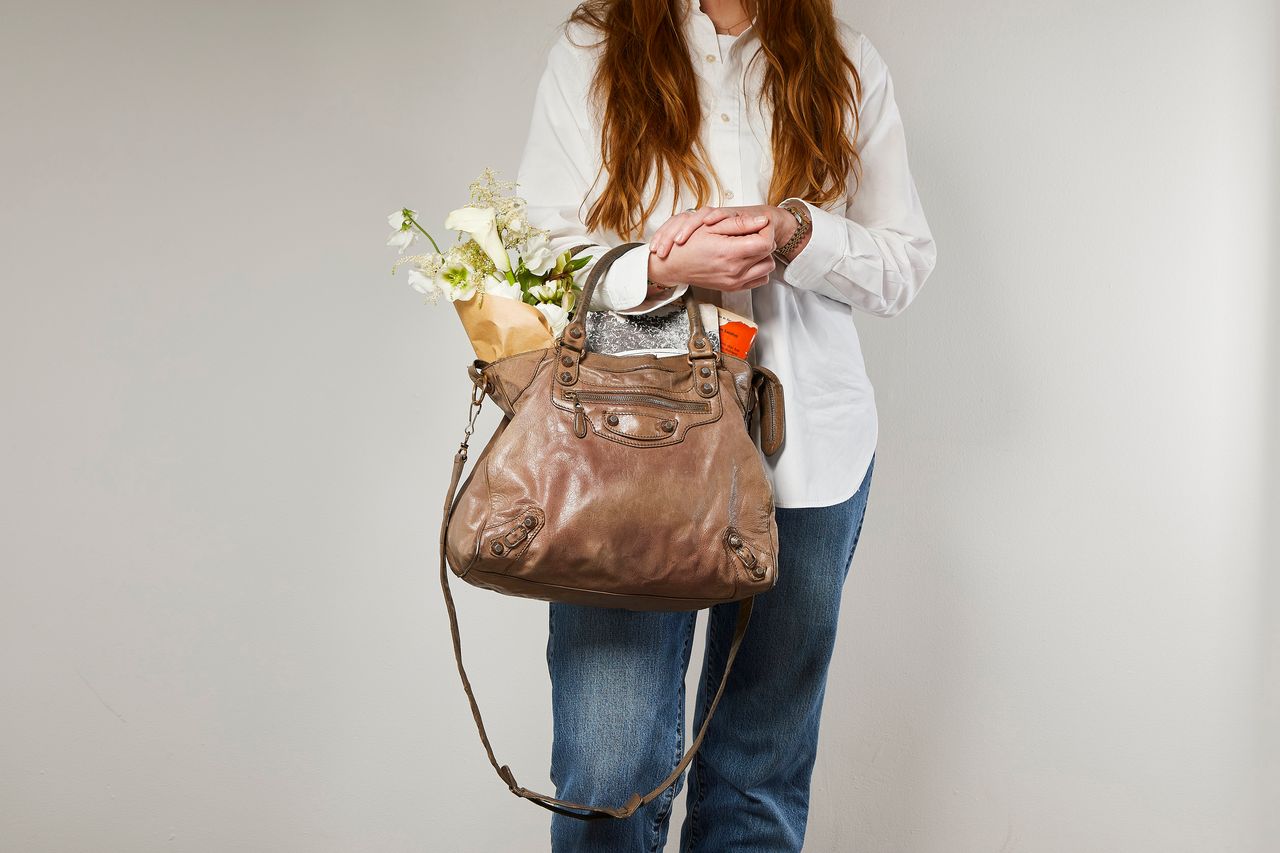Should You Beat Up Your Birkin? Why Worn-In Luxury Bags Are Selling Fast
Stylish women are pooh-pooing pristine purses. Is it fueled by inflation? Y2K nostalgia? Is it just cool? An investigation into the tattered-bag trend.
ABOUT 20 YEARS ago, while dining in San Francisco, Lisa Unger Sandman was nearly startled out of her seat. “Oh, my God! That should never be on the floor!” shrieked a woman at a nearby table, pointing to Ms. Unger Sandman’s black Hermès Kelly bag. Chastened, Ms. Unger Sandman, now a retired banker in Raleigh, N.C., snatched up her purse which, in the current market, often costs at least five figures. “It caught me off guard,” she recalled. Today, Ms. Unger Sandman, 60, would ignore such a reprimand and isn’t so worried if her Kelly risks bodily harm. “If a bag has a scratch on it, that means you’ve enjoyed it. I’m happy with the patina.”
Ms. Sandman’s attitude reflects a growing trend. Lately, women are both embracing their handbags’ scratches and stains and seeking out visibly worn-in styles on the secondhand market. In its 2023 luxury consignment report, resale site the RealReal noted higher demand than ever for bags in “fair” (i.e., heavily worn) condition. Similarly, at resale platform Vestiaire Collective, co-founder Sophie Hersan reports that sales of worn-in designer bags have jumped 13% in the last six months.
Why the sudden craving for beat-up bags? One of the biggest draws, posits Katie Devlin of trends and insights company Stylus, is the Y2K revival and the resurgence of “indie sleaze,” a grungy, aughts-era aesthetic. She references the circa-2010 style of Mary-Kate and Ashley Olsen. Famously on their arms back then: decimated Hermès Kellys and Balenciaga bags (like the one shown here). “It’s the idea of looking expensive but like you don’t care—of not looking overly curated,” said Ms. Devlin.
In that regard, the trend, which encompasses luxury bags by the likes of Chanel, Gucci and Louis Vuitton, as well as label-free vintage styles, may be a backlash to the picture-perfect world of Instagram and wealthy reality TV stars (see the seemingly untouched designer bags that line the Kardashian clan’s walk-in closets). “There’s a move away from this idealistic, filtered look we’re so used to seeing,” said Dayna Isom Johnson, a trend expert at online marketplace Etsy, where searches for Y2K handbags are up 51% in the last three months compared to the same period last year. “Now people are really embracing the realness and messiness that comes with living everyday life.” Not using something that costs so much, Ms. Isom added, makes people feel “very wasteful.” Elizabeth Layne, chief marketing officer of resale site Rebag, has observed a resistance to feeling “too precious about [luxury] workhorse bags of lower grades. You don’t have to worry if it gets a scuff.”
New York stylist Malina Joseph Gilchrist agrees. “There’s a quiet luxury thing happening…a reaction to a congested market of handbags that are logoed and attention-seeking.” With a worn-in bag, she said, “you look like you’re not trying too hard.”
For Sapna Bhatla, 42, a business strategy consultant in Philadelphia, beat-up bags—whether trendy or not—speak to her identity. After immigrating to the U.S. from India, her style-savvy mother would combine her traditional attire with vintage estate-sale finds. So “pristine feels contrived and inauthentic to me,” Ms. Bhatla said. “If you see my body, I have scars. I have marks. I have a life that’s been lived. And I’m happy to have signs to remind me of it. I like things that show a test of time and sturdiness and resilience.”
She owns an arsenal of worn-in designer purses—some she marred herself, others that she scooped up on eBay. Among her favourites is a decades-old, no-name leather bag she found at a Paris flea market. “I’m not so crazy about brand names when it comes to vintage. If it’s here today, it’s already good quality.”
Those scars should not be haphazardly patched up, said Sofia Bernardin, founder of luxury vintage platform ReSee. “There’s nothing worse than a badly repaired bag. It’s like a woman who’s had too much Botox—she’d have been better off not doing anything.” Still, not all decay is desirable, said Kristin Whalen, 36, a San Francisco senior director of client management and bag obsessive who’s had some of her styles since high school. For her, protruding structural wires and age-induced deformities are nonstarters. Trend analyst Ms. Devlin maintains that, while the optimal degree of destruction is a personal choice, “if it’s not functional and your strap is falling off, it’s time to say goodbye.”
Is inflation driving this so-called “trend”? Recently, the cost of new luxury bags has skyrocketed. According to Jefferies Group, the price of Chanel’s coveted small classic flap bag increased about 60% between 2019 and 2022 in the U.S. Meanwhile, on the RealReal, bags in “fair condition” cost on average 33% less than already-discounted “good condition” options, said Noelle Sciacca, that site’s fashion lead. Lara Osborn, reseller Fashionphile’s vice president of procurement, offers a reality check. “We have to ask ourselves: Is a [worn-in] bag really chic, or is the economy just dictating that we’ll be wearing bags with a lot more love?”
Ms. Joseph Gilchrist insists it’s the former. If your bag’s beat-up, she said, “you just look cooler.”
How to Make A Beautiful Disaster
Is your fancy handbag looking too new? Here, four inadvisable but foolproof ways to pulverise even the sturdiest purse.
1. Toss your pristine purchase in the washing machine—and choose the most punishing spin cycle. For extra distress, add bleach.
2. Give that immaculate purse to your puppy. If he seems uninterested, slather it in peanut butter and present it again.
3. Buy a top-notch bow and arrow and use your bag for target practice. Ignore its faint whimpers each time it’s pierced.
4. Drop it at an osprey breeding site so a hen can use it in her nest. Once the chicks have fledged, retrieve your totally tattered tote.
The Wall Street Journal is not compensated by retailers listed in its articles as outlets for products. Listed retailers frequently are not the sole retail outlets.
 Copyright 2020, Dow Jones & Company, Inc. All Rights Reserved Worldwide. LEARN MORE
Copyright 2020, Dow Jones & Company, Inc. All Rights Reserved Worldwide. LEARN MORE
This stylish family home combines a classic palette and finishes with a flexible floorplan
Just 55 minutes from Sydney, make this your creative getaway located in the majestic Hawkesbury region.
Continued stagflation and cost of living pressures are causing couples to think twice about starting a family, new data has revealed, with long term impacts expected
Australia is in the midst of a ‘baby recession’ with preliminary estimates showing the number of births in 2023 fell by more than four percent to the lowest level since 2006, according to KPMG. The consultancy firm says this reflects the impact of cost-of-living pressures on the feasibility of younger Australians starting a family.
KPMG estimates that 289,100 babies were born in 2023. This compares to 300,684 babies in 2022 and 309,996 in 2021, according to the Australian Bureau of Statistics (ABS). KPMG urban economist Terry Rawnsley said weak economic growth often leads to a reduced number of births. In 2023, ABS data shows gross domestic product (GDP) fell to 1.5 percent. Despite the population growing by 2.5 percent in 2023, GDP on a per capita basis went into negative territory, down one percent over the 12 months.
“Birth rates provide insight into long-term population growth as well as the current confidence of Australian families,” said Mr Rawnsley. “We haven’t seen such a sharp drop in births in Australia since the period of economic stagflation in the 1970s, which coincided with the initial widespread adoption of the contraceptive pill.”
Mr Rawnsley said many Australian couples delayed starting a family while the pandemic played out in 2020. The number of births fell from 305,832 in 2019 to 294,369 in 2020. Then in 2021, strong employment and vast amounts of stimulus money, along with high household savings due to lockdowns, gave couples better financial means to have a baby. This led to a rebound in births.
However, the re-opening of the global economy in 2022 led to soaring inflation. By the start of 2023, the Australian consumer price index (CPI) had risen to its highest level since 1990 at 7.8 percent per annum. By that stage, the Reserve Bank had already commenced an aggressive rate-hiking strategy to fight inflation and had raised the cash rate every month between May and December 2022.
Five more rate hikes during 2023 put further pressure on couples with mortgages and put the brakes on family formation. “This combination of the pandemic and rapid economic changes explains the spike and subsequent sharp decline in birth rates we have observed over the past four years,” Mr Rawnsley said.
The impact of high costs of living on couples’ decision to have a baby is highlighted in births data for the capital cities. KPMG estimates there were 60,860 births in Sydney in 2023, down 8.6 percent from 2019. There were 56,270 births in Melbourne, down 7.3 percent. In Perth, there were 25,020 births, down 6 percent, while in Brisbane there were 30,250 births, down 4.3 percent. Canberra was the only capital city where there was no fall in the number of births in 2023 compared to 2019.
“CPI growth in Canberra has been slightly subdued compared to that in other major cities, and the economic outlook has remained strong,” Mr Rawnsley said. “This means families have not been hurting as much as those in other capital cities, and in turn, we’ve seen a stabilisation of births in the ACT.”
This stylish family home combines a classic palette and finishes with a flexible floorplan
Just 55 minutes from Sydney, make this your creative getaway located in the majestic Hawkesbury region.






















